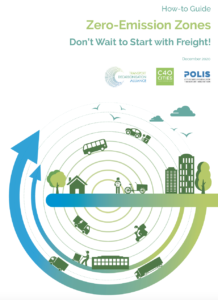POLIS, Transport Decarbonisation Alliance (TDA), and C40 cities launched the How-to Guide, “Zero-Emission Zones: Don’t Wait to start with Freight”. The guide presents experience and advice on developing a zero-emission zone for urban freight, from public and private-sector representatives around the world.
While urban freight produces air pollution and CO2 emissions, few cities and countries have developed a vision for zero-emission urban freight. The guide prepared by the TDA, C40, and POLIS invites urban planners, transport officials, freight operators, shippers, and other stakeholders to consider the advantages of creating zero-emission zones for freight (ZEZ-Fs) in and around cities. It introduces strategies and experiences of developing ZEZ-Fs in cities from London to Shenzhen and Santa Monica to Rotterdam, offering an overview of challenges and opportunities and advice from pioneers about effective approaches.
Toni Orsulic, Vice Mayor of Transport, City of Gothenburg, and President of POLIS, declares: “In Gothenburg, we have been planning and managing zero-emission city logistics for years. Our initiatives, including Stadsleveransen, one of the consolidation centers of Gothenburg, are recognized as best practices at the European level. The regulation of logistics movements is necessary to reduce pollution and emissions, but also to make the delivery of goods and services more efficient. We are convinced that this guide is a useful tool to support us and other cities in identifying the steps and success factors to accelerate the transition to zero-emission city logistics”.
Highlights from the guide are:
- Devising a ZEZ for freight is a complex process involving many stakeholders. Owners and operators of freight vehicles range from multinational companies to sole-proprietor shops, and from tradespeople to professionals providing construction, repair, and maintenance services. Understanding the interests and concerns of the many stakeholders is key to enabling collaboration and devising effective rules and incentives regulating ZEZ-Fs.
- Preferencing zero-emission freight vehicles in zone accessibility, time-windows, and through subsidies and other incentives can help jumpstart the market for zero-emission freight vehicles and speed up the overall transition to zero-carbon transport.
- The charging infrastructure for zero-emission freight vehicles can be a hurdle. A coherent strategy needs to be developed cooperatively with logistics and charging-infrastructure operators and the public sector.
- Comprehensive data on freight vehicles, their routes, and types of use is essential to designing a successful ZEZ-F. Since the data typically comes from private operators, cities are developing innovative methods and incentives for information sharing.
- Well-designed ZEZ-Fs encourage more efficient logistics (reducing the number of trips), a better mix of transport modes (e.g. using shared cargo bikes or light electric vehicles), and a transition of the remaining vans and trucks to zero-emission.
- Policies may need to be aligned across different levels of government and neighboring districts or even countries. Cities often lack the jurisdiction to regulate a zero-emission zone. And many companies operate across multiple cities and neighboring countries — so common approaches allow them to plan and invest with greater confidence.
It is a very helpful guide for stakeholders in public-private partnerships in realizing ZEZ-Fs offering many inspiring ideas. The guide does not (yet) address innovation in pick-up-points, ITS, the effect on urban planning (both residential and industrial areas), intelligent access, monitoring results, and the opportunities of autonomous city logistics vehicles. Some ideas for the next edition of the guide?
You can find the guide here.

